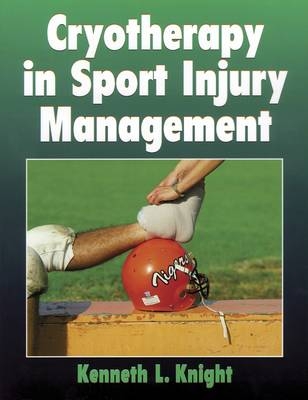
Cryotherapy in Sport Injury Management
Human Kinetics Publishers (Verlag)
978-0-87322-771-1 (ISBN)
- Titel ist leider vergriffen;
keine Neuauflage - Artikel merken
Kenneth L. Knight, PhD, ATC, has dedicated his professional career to understanding cryotherapy. He is a professor of athletic training at Indiana State University, where he is chair of the Athletic Training Department. He is also director of ISU's Sports Injury Research Laboratory, which is recognized as the world leader in sport injury cryotherapy research. Nationally recognized in athletic training education, Knight has served as a trainer for high school, junior college, and college teams for over 25 years and as an athletic training educator since 1973. The National Athletic Trainers Association recognized Knight as the Educator of the Year in 1995. Knight has published two books and numerous articles on sports medicine and serves as editor-in-chief of the Journal of Athletic Training, the official journal of the National Athletic Trainers Association. He and his wife Shari live in Terre Haute, Indiana.
Part I. Introduction to CryotherapyChapter 1. The What and Why of CryotherapyWhy the Confusion? What Is Cryotherapy?Cryotherapeutic Techniques What Happens When Cold Is Applied?Heat vs. Cold: When and Why SummaryChapter 2. Historical PerspectiveHeat vs. ColdEarly Medical Uses of Cold Cold and Immediate CareUse of Ice for Rehabilitation: The History of CryokineticsSummaryPart II. The Scientific Basis of Cryotherapy Theory vs. TechniqueCentral and Local ResponsesPathophysiologyChapter 3. Inflammation and Wound RepairThe Inflammatory ResponseThe Sport Injury ModelSecondary InjurySwelling: Hemorrhaging and EdemaThe Healing ProcessSummaryChapter 4. Sport Injury RehabilitationRehabilitation vs. ReconditioningWhat Rehabilitation Is NotPrinciples of RehabilitationA Systems Approach to Total Rehabilitation: The 10 PhasesWhat Modality Is Used When?The Psychology of RehabilitationSummaryChapter 5. Temperature Changes Resulting From Cold ApplicationsHeat and How It Is MeasuredHeat ConductionHeat CapacitySurface TemperatureDeep-Tissue TemperatureIntraarticular TemperatureRewarming Following Cold ApplicationsControversy Over Contralateral Limb TemperaturesAdaptation to a Cold EnvironmentSummaryChapter 6. Metabolism and InflammationDecreased Metabolism at Lower Temperatures Cryotherapy in Cardiac Surgery and Transplant SurgeryStudies of Induced Injuries Cryotherapy and InflammationEffects of Cold on Wound HealingSummaryChapter 7. Rest, Ice, Compression, Elevation, and Stabilization for the Immediate Care of Acute Traumatic InjuriesClinical StudiesEffects of Ice During Immediate CareEffects of Ice on SwellingEffects of Compression on SwellingEffects of Elevation on SwellingRest StabilizationWhat Types of Injuries Are Treated With RICES?Ice Application ProtocolsSummaryChapter 8. Orthopedic Surgery and CryotherapyPostsurgical CryotherapyPresurgical CryotherapyCryoanalgesiaSummaryChapter 9. Circulatory Effects of Therapeutic Cold ApplicationsWhat Is Cold-Induced Vasodilation?What Is Dilation?Cold DilemmaEvidence for CIVDCIVD: A Red HerringBenefits of the CIVD TheoryContrast BathsSummaryChapter 10. Neurological and Neuromuscular Effects of Cold ApplicationsEffects of Cold on Sensory Nerve FunctionsEffects of Cold on Neuromuscular Parameters Tetanic TensionEffects of Cold on ReflexesSummaryChapter 11. Pain and Cold ApplicationsWhat Is Pain?Measuring PainCold-Induced PainCoping With and Adapting to Cold-Induced PainHow Does Cold Relieve Pain?Pain Reduction With Cryotherapy: Clinical UsesSummaryChapter 12. Reduction of Muscle Spasm With Cold TherapyClinical StudiesMechanism of Spasm ReliefSummaryChapter 13. Tissue and Joint StiffnessConnective TissueMuscle StiffnessJoint StiffnessManual DexterityManual PerformanceCryotherapy During Sports ActivitiesMuscle and Joint Stiffness as a SymptomSummaryChapter 14. Problems, Precautions, and Contraindications in Cold TherapyFrostbite and Related ConditionsPressure-Related Nerve PalsyCold HypersensitivityVasospastic DisordersContraindicationsPrecautionsSummaryPart III: Clinical Techniques Involving CryotherapyChapter 15. Methods of Cold ApplicationIce PacksCold-Gel PacksArtificial Ice Cube PacksChemical Cold PacksIce Immersion Cold WhirlpoolsIce MassageCold MachinesVapo-Coolant Spray Vapo-Coolant CuffsChapter 16. Initial Care of Acute Injuries: The RICES TechniqueSummary of Rationale for RICES Equipment Needed Preapplication Procedures Application Procedures Postapplication Procedures Key Points for Applying RICESChapter 17. Cryokinetics in Rehabilitation of Joint SprainsSummary of Rationale for CryokineticsEquipment NeededPreapplication ProceduresApplication ProceduresAlternativesKey Points for Using CryokineticsChapter 18. Relieving Acute Muscle Spasm: CryostretchCryostretchSummary of Rationale for Cryostretching Equipment NeededPreapplication ProceduresApplication ProceduresCombined Cryostretch and CryokineticsKey Points for Using CryostretchChapter 19. Postsurgical CryotherapyAircast Cryo CuffDura-Kold PacksCirculating Cold-Water MachinesChapter 20. Cryotherapeutic Techniques for Relieving PainRelieving Menstrual CrampsApplication ProceduresTreating HeadachesPainless Injection and VenipunctureMyofascial Trigger Point TherapyApplication ProceduresChapter 21. Miscellaneous Cryotherapeutic TechniquesMedicated Ice for AbrasionsEquipment NeededPreapplication ProceduresApplication ProceduresStretching Connective TissueEquipment Needed Application ProceduresCooling Athletes During Exercise in a Hot EnvironmentMinimizing Cold Sores Application ProceduresMinimizing Blisters Prevention of Hair Loss During Doxorubicin Chemotherapy
| Erscheint lt. Verlag | 1.8.1995 |
|---|---|
| Zusatzinfo | 77 black & white illustrations, 70 black & white halftones |
| Verlagsort | Champaign |
| Sprache | englisch |
| Maße | 216 x 279 mm |
| Gewicht | 885 g |
| Themenwelt | Medizin / Pharmazie ► Medizinische Fachgebiete ► Sportmedizin |
| Studium ► 1. Studienabschnitt (Vorklinik) ► Physiologie | |
| ISBN-10 | 0-87322-771-9 / 0873227719 |
| ISBN-13 | 978-0-87322-771-1 / 9780873227711 |
| Zustand | Neuware |
| Haben Sie eine Frage zum Produkt? |
aus dem Bereich


